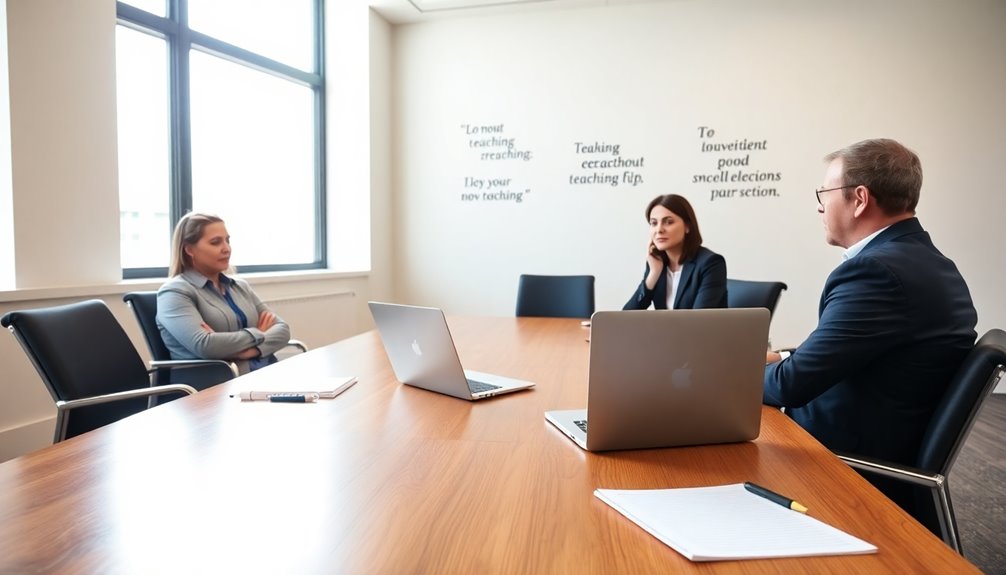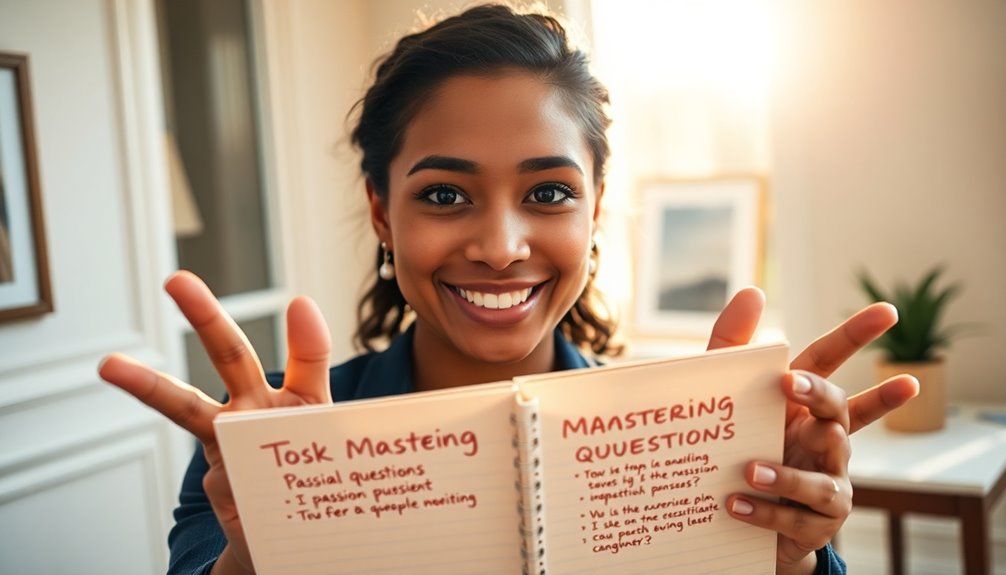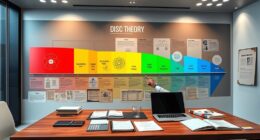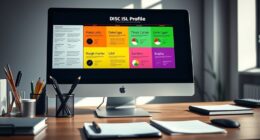To ace your teacher job interview, start by understanding the school's culture and aligning your teaching philosophy with its values. Prepare for common questions, especially about classroom management and diversity in learning needs. Highlight relevant strengths and be honest about weaknesses, showing your commitment to professional growth. Share impactful experiences that showcase your teaching effectiveness. Don't forget to ask thoughtful questions to engage your interviewers. Finally, maintain professional communication, and follow up promptly with a thank-you note. Success in interviews is about preparation and authenticity, and there's more valuable information waiting for you to explore.
Key Takeaways
- Research the school's mission and values to align your teaching philosophy with their educational priorities during the interview.
- Use the STAR method to structure responses to situational questions, providing clear examples of classroom challenges and resolutions.
- Highlight your strengths relevant to the school's needs while acknowledging weaknesses and outlining your strategies for professional growth.
- Share impactful personal experiences that illustrate your teaching effectiveness and adaptability to diverse learning styles.
- Follow up with a personalized thank-you email within 24-48 hours, referencing specific discussion points to reinforce your interest in the position.
Understand the School's Culture

Understanding a school's culture is essential for acing your job interview. To impress the interviewers, research the school's mission statement and values to grasp its educational priorities and community focus. This knowledge illustrates you care about the environment where you'll be teaching and how it aligns with your own teaching philosophy.
Familiarize yourself with recent achievements and initiatives of the school. This reflects your genuine interest and commitment to contributing to a positive impact on students' lives. Engaging with current or former teachers offers valuable insights into the school culture, including collaboration among staff and the level of community involvement.
Don't forget to observe the school's social media presence. This can reveal events, programs, and activities that reflect its culture and student engagement. When crafting your responses during the interview, tailor them to showcase how your teaching philosophy aligns with the school's culture and values. Highlight your commitment to fostering a supportive classroom environment and your interest in professional development opportunities. By doing so, you position yourself as a candidate who's not only aware of but enthusiastic to contribute to the school community.
Reflect on Your Teaching Philosophy

Your teaching philosophy is the foundation of your identity as an educator, shaping how you approach instruction and student engagement. It outlines your beliefs about teaching and learning, emphasizing holistic student development and addressing diverse learning needs. A strong philosophy reflects your personal values and aligns with the school's mission, creating a supportive and motivating environment.
Articulating your teaching philosophy not only showcases your commitment to student success but also helps you stand out in interviews. Here's how you can structure your beliefs:
| Component | Description | Importance |
|---|---|---|
| Educator's Beliefs | Your core values about education and student learning | Guides your teaching approach |
| Instructional Strategies | Methods you use to engage students | Guarantees inclusivity and caters to learning styles |
| Positive School Culture | Your role in fostering a supportive environment | Promotes student development and wellbeing |
Defining your teaching philosophy also aids in decision-making, classroom management, and assessment practices. By aligning your approach with educational standards and best practices, you can create an inclusive, engaging atmosphere that nurtures all students.
Prepare for Common Questions

Once you've articulated your teaching philosophy, it's time to prepare for common interview questions that can highlight your strengths and experiences as an educator. Anticipate questions surrounding your classroom management strategies and how you address diverse student needs. Here are some key areas to focus on:
- Teaching Philosophy: Be ready to explain how your beliefs shape your approach to education.
- Classroom Management: Prepare examples of how you've handled challenging situations effectively.
- Diverse Student Needs: Think of specific instances where you adapted your teaching to support all learners.
- Collaboration: Share experiences working with colleagues and parents to foster student success.
Utilize the STAR method (Situation, Task, Action, Result) to structure your responses, especially for situational interview questions. This technique allows you to provide clear examples of your problem-solving abilities. Also, don't forget to highlight impactful teaching moments that showcase your commitment to student learning and your ability to engage students effectively. Practicing these responses will not only boost your confidence but also guarantee you present yourself as a well-rounded candidate ready to make a difference in the classroom. Additionally, consider how your approach to teaching can benefit from understanding the importance of relaxation before sleep for both you and your students, enhancing overall classroom energy.
Highlight Your Strengths and Weaknesses

When you're asked about your strengths and weaknesses, be ready to highlight the skills that make you a great fit for the school. Clearly articulate how your strengths align with their needs, and don't shy away from discussing your weaknesses honestly. This balance shows your commitment to growth and your understanding of the educational landscape.
Articulate Relevant Strengths Clearly
While preparing for a teacher job interview, it is essential to articulate your relevant strengths clearly and address your weaknesses honestly. When interviewers ask about your strengths, focus on qualities that align with the school's needs. Use the STAR method to structure your responses, highlighting specific teaching experiences. Here are some strengths you might consider emphasizing:
- Communication: Discuss how effective communication helps you connect with students and parents.
- Adaptability: Provide examples of how you've adjusted your teaching methods to meet diverse learning styles.
- Patience: Share a situation where your patience facilitated a breakthrough for a struggling student.
- Team Collaboration: Illustrate how you've successfully collaborated with colleagues to enhance the curriculum.
Acknowledge Weaknesses Openly
Acknowledging weaknesses openly can set you apart in a teacher job interview, as it reflects your authenticity and self-awareness. Interviewers appreciate candidates who can honestly discuss areas for growth. When you're asked about your weaknesses, share specific examples, but don't stop there. Discuss the strategies for improvement you've implemented, showcasing your growth mindset.
For instance, if classroom management is a challenge for you, explain how you've sought mentorship or attended workshops focused on this area. This not only demonstrates your commitment to continuous improvement but also highlights your proactive approach to professional development.
Align Strengths With Needs
Highlighting your strengths in relation to the school's needs is essential for making a strong impression in your teacher job interview. Start by identifying key strengths that align with the school's mission, such as:
- Strong Communication Skills: Showcase how these skills enhance classroom engagement.
- Adaptability in Teaching Methods: Discuss how you've tailored lessons to meet diverse student needs.
- Experience with Innovative Educational Technologies: Provide specific examples of how you've integrated tech to boost learning.
- Commitment to Professional Development: Explain how ongoing training reflects your growth mindset.
When discussing your strengths, use specific examples from past experiences to illustrate their impact on student learning or classroom management. For instance, if you've successfully implemented a new teaching method that improved student engagement, share that story.
Also, be honest about your weaknesses. Emphasize how you're actively working to improve through professional development or reflection. This shows your growth mindset and commitment to continuous improvement. Remember, aligning your strengths with the school's needs not only highlights your qualifications but also demonstrates your dedication to contributing positively to the educational environment.
Share Impactful Personal Experiences

Sharing impactful personal experiences during a job interview can greatly enhance your candidacy as a teacher. When you recount a personal story about a successful intervention with a struggling student, you demonstrate your commitment to student success and your ability to adapt teaching methods to meet diverse needs. Highlighting an instance where innovative lesson planning boosted student engagement showcases your creativity and effectiveness as an educator.
Consider discussing a challenging classroom situation and the strategies you implemented to resolve it. This not only illustrates your problem-solving skills but also reflects your resilience in the face of adversity. Sharing anecdotes that display your passion for teaching and the positive impact you've made in students' lives will resonate with interviewers, conveying your dedication to the profession.
Additionally, providing examples of collaboration with colleagues on a successful school project emphasizes your teamwork skills and contributions to the school community. By integrating these impactful experiences into your responses during teacher interviews, you're not just answering questions; you're painting a vivid picture of the educator you are and the difference you can make.
Discuss Classroom Management Strategies

Equipping yourself with effective classroom management strategies is just as important as sharing impactful personal experiences. To create a positive and structured environment, consider implementing the following strategies:
- Establish Clear Behavioral Expectations: Collaborate with your students to define rules and consequences. This guarantees they understand what's expected and promotes accountability.
- Implement Structured Routines: Create consistency in your classroom. Structured routines help students feel secure, which can greatly reduce disruptive behavior.
- Utilize Positive Reinforcement: Encourage desired behaviors through praise and rewards. Positive reinforcement fosters a supportive classroom atmosphere and motivates students to engage more actively.
- Monitor Student Behavior: Regularly observe and adjust your management strategies based on the diverse needs of your learners. This flexibility allows you to support all students effectively.
Additionally, maintaining open communication with parents and colleagues is essential. It builds a support network that can address behavioral challenges more effectively. By focusing on these classroom management strategies, you create an environment where all students can thrive and succeed.
Moreover, establishing healthy boundaries in the classroom can enhance respect and promote a better learning environment for everyone involved.
Emphasize Professional Development Commitment

When you're preparing for a teacher job interview, showcasing your commitment to professional development can set you apart. Highlight your continuous learning opportunities, such as attending workshops regularly and setting personal growth goals. This not only emphasizes your dedication but also reflects your desire to improve your teaching practices for the benefit of your students.
Continuous Learning Opportunities
Embracing continuous learning opportunities is essential for educators aiming to enhance their teaching effectiveness. By committing to ongoing professional development, you'll not only refine your skills but also positively influence your students' outcomes. Here are four key aspects to contemplate:
- Participate in Workshops: Engage in workshops and seminars to collaborate with peers. Sharing best practices can introduce you to innovative teaching techniques that can elevate your classroom experience.
- Reflect on Your Practice: Regularly assess your performance through reflective practice. This helps you identify areas for improvement and set personal growth goals.
- Seek Feedback: Don't shy away from feedback; it's a crucial component of professional development. Constructive criticism from mentors and colleagues can foster accountability and motivate you to adopt new strategies.
- Stay Updated: Keep yourself informed about the latest educational trends and research. This knowledge will allow you to implement effective teaching strategies that directly enhance student learning.
Attend Workshops Regularly
How can attending workshops regularly transform your teaching practice? By committing to professional development, you stay updated on the latest educational trends and innovative teaching strategies. This not only enhances your effectiveness but also enriches the learning environment for your students. In a teacher interview, showcasing your dedication to continuous learning can set you apart from other candidates.
Workshops provide practical, hands-on experiences that you can immediately implement in your classroom. They also foster collaboration, allowing you to network with fellow educators and exchange valuable resources and best practices. This collaborative spirit can lead to improved student outcomes, as you incorporate new ideas and approaches into your teaching.
Many educational institutions now require or encourage a specific number of professional development hours annually. Regular attendance at workshops not only fulfills these requirements but also demonstrates your commitment to lifelong learning—a quality that hiring managers highly value. By investing in your growth as an educator, you signal that you're serious about your career and dedicated to providing the best possible education for your students. So, make it a priority to attend workshops regularly and watch your teaching practice flourish.
Set Personal Growth Goals
What strategies can you employ to set personal growth goals as an educator? Setting these goals is essential for your continuous improvement and effectiveness in the classroom. Here are four strategies to take into account:
- Engage in Professional Development: Attend workshops and conferences that focus on the latest teaching strategies. This keeps you informed and allows you to implement new methods that enhance student learning outcomes.
- Practice Self-Reflection: Regularly assess your teaching practices. Take time to reflect on what works and what doesn't, which helps you identify specific areas for growth.
- Seek Feedback: Collaborate with peers and ask for constructive feedback. This outside perspective can reveal blind spots in your teaching, guiding you in setting measurable personal growth goals.
- Commit to Lifelong Learning: Stay curious and open to new ideas. Embracing lifelong learning not only enriches your professional development but also showcases your dedication to fostering student success. Additionally, creating a unique atmosphere in your classroom can greatly enhance student engagement and learning.
Engage in Lesson Planning Discussions

Engaging in lesson planning discussions is essential for developing effective educational strategies that meet diverse student needs. By collaborating with colleagues, you can share best practices and innovative ideas that enhance your lesson planning process. This collaboration allows you to incorporate a variety of instructional strategies, such as group work, hands-on activities, and technology integration, ensuring that you address different learning styles.
Regularly seeking student feedback is critical for refining your teaching methods. It helps you gauge student understanding and adjust your approaches based on their responses. Utilizing formative assessments throughout your lessons will further inform your instructional adjustments in real-time, ensuring that all students grasp the material.
Setting clear objectives aligned with educational standards is fundamental in lesson planning. By doing so, you clarify the intended learning outcomes and help students understand what's expected of them. Engaging in these discussions not only improves the overall quality of your instruction but also fosters a supportive learning environment where students can thrive. Embrace this collaborative process, and you'll create a more dynamic, responsive classroom that meets the needs of every learner.
Showcase Differentiation Techniques

When it comes to showcasing differentiation techniques in your interview, highlight how you address diverse learning styles through tailored instructional strategies. Discuss your use of flexible grouping to guarantee that every student receives the support they need. This approach not only fosters an inclusive environment but also boosts engagement and achievement in your classroom.
Diverse Learning Styles Addressed
Understanding and addressing diverse learning styles is essential for effective teaching, as it allows you to create a more inclusive classroom environment. By recognizing that students learn in different ways, you can tailor your classroom instruction to meet their unique needs. Here are some techniques to evaluate:
- Utilize various instructional strategies: Incorporate hands-on activities, group discussions, and multimedia presentations to engage visual, auditory, and kinesthetic learners.
- Implement formative assessments: Use quizzes and exit tickets to gauge student understanding and adjust your teaching methods accordingly.
- Create flexible grouping: Arrange students in pairs or small groups based on similar learning styles or interests. This fosters collaboration and enhances peer learning.
- Leverage technology resources: Use educational apps and online platforms to provide personalized learning experiences that cater to individual strengths and weaknesses.
Additionally, recognizing the importance of executive function skills can help you support students in developing essential cognitive processes that enhance their learning and self-regulation.
Tailored Instructional Strategies
Tailored instructional strategies are key to meeting the diverse needs of your students. By employing effective differentiation techniques, you can adapt your teaching methods to guarantee every learner engages meaningfully with the content. Here are some strategies you can implement:
| Differentiation Technique | Description | Example |
|---|---|---|
| Varying Content | Use different types of content to enhance understanding. | Visual aids for visual learners. |
| Flexible Grouping | Create dynamic groups for collaboration and support. | Mixed-ability learning teams. |
| Formative Assessments | Use ongoing feedback to adjust teaching methods. | Quick quizzes to gauge understanding. |
| Personalized Learning | Enable students to work at their own pace. | Educational apps tailored to interests. |
| Technology in the Classroom | Integrate tech to facilitate tailored content access. | Online resources for diverse learners. |
Incorporating these techniques will foster a more inclusive classroom environment. By leveraging formative assessments, you can continuously refine your approach. Meanwhile, technology in the classroom can facilitate personalized learning paths, guaranteeing each student can thrive. Additionally, the Law of Attraction principles can enhance motivation and positivity in the learning environment. Remember, effective differentiation is about meeting your students where they are!
Flexible Grouping Techniques
Creating an inclusive learning environment often means embracing flexible grouping techniques. These strategies allow you to tailor your teaching to meet various learning styles, enhancing collaboration among students and fostering engagement. By grouping students dynamically based on their abilities, interests, or progress, you can create opportunities for peer learning that ultimately improve academic outcomes.
Here are four effective flexible grouping techniques to contemplate:
- Heterogeneous Groups: Mix students of varying abilities to promote peer learning and support diverse perspectives.
- Homogeneous Groups: Group students with similar skill levels for targeted practice, enabling focused skill development.
- Interest-Based Groups: Form groups based on student interests to increase motivation and relevance in learning.
- Dynamic Re-grouping: Regularly change groups based on ongoing assessment and student progress, ensuring that everyone's needs are met.
Prepare Thoughtful Questions to Ask

Preparing thoughtful questions to ask during your teacher job interview is essential for demonstrating your genuine interest in the position and the school. Consider inquiring about the school's culture, support systems for new teachers, and professional development opportunities. Your questions can reveal a lot about how well you might fit in.
Here's a quick guide to help you formulate your questions:
| Topic | Sample Questions |
|---|---|
| Support Systems | What support systems are in place for new teachers? |
| Classroom Management | How does the school approach student discipline and behavior management? |
| Community Involvement | What community involvement initiatives does the school encourage? |
Additionally, ask about collaboration among staff, such as how teachers share resources and best practices. Finally, clarify the next steps in the interview process to show your enthusiasm. By preparing these questions, you'll not only gain valuable insights but also demonstrate your commitment to becoming an effective part of the school community.
Practice Professional Communication Skills

Practicing professional communication skills is essential for making a strong impression during your teacher job interview. Your ability to articulate ideas clearly, actively listen, and adapt your language based on the audience can set you apart. Here are some key strategies to enhance your communication:
- Active Listening: Pay close attention to the interviewer's questions and comments. This shows respect and helps you respond thoughtfully.
- Non-Verbal Communication: Maintain eye contact and use appropriate body language. This conveys confidence and engagement, vital in a teacher interview.
- Practice Responses: Rehearse common interview questions related to your teaching philosophy and experience. This will help you communicate your thoughts coherently under pressure.
- Role-Playing Exercises: Engage with peers in mock interviews. This practice can refine your responses and boost your ability to articulate your ideas.
Demonstrating professionalism in communication not only reflects your teaching competence but also establishes how you'll interact with students, parents, and colleagues in the future. By honing these skills, you'll approach your teacher interview with confidence and clarity, making a lasting impression on the interviewers.
Follow Up After the Interview

A thoughtful follow-up after your interview can make a significant difference in how you're perceived by the hiring committee. Sending a thank-you email within 24-48 hours shows appreciation and reinforces your interest in the position. In your follow-up, make certain to reiterate specific points discussed during the interview to demonstrate your engagement and attentiveness.
Here's a quick reference table to guide your follow-up process:
| Step | Action | Purpose |
|---|---|---|
| 1. Timing | Send within 24-48 hours | Shows promptness and enthusiasm |
| 2. Content | Include a thank-you note | Expresses appreciation for their time |
| 3. Personalization | Mention specific discussion points | Reinforces your attentiveness |
| 4. Professionalism | Proofread before sending | Maintains a positive impression |
| 5. Additional Thoughts | Address any lingering questions | Further demonstrates your interest |
A well-crafted follow-up message not only helps you stand out among other candidates but also leaves a lasting positive impression on the interviewers. Remember, professionalism is key, so make sure your communication reflects your enthusiasm for the role.
Frequently Asked Questions
What Are the 7 Most Common Interview Questions and Answers for Teachers?
When preparing for a teacher interview, you'll likely encounter questions about your teaching philosophy, classroom management techniques, and how you address diverse student needs. You might also be asked about your strengths and weaknesses, along with examples of handling challenging situations. Be ready to discuss collaboration with colleagues and communication with parents. Finally, expect situational questions that assess your ability to motivate students and implement effective assessment strategies.
What Is Your Greatest Weakness as a Teacher?
When you're asked about your greatest weakness as a teacher, it's vital to choose an area for improvement that feels authentic. Maybe you struggle with time management. You can explain how you've recognized this challenge and are actively working on it by attending workshops or using digital tools to organize your schedule better. Reflecting on your progress will show how this journey has enhanced your teaching and positively impacted your students' learning experience.
How to Ace a Teacher Interview?
To ace a teacher interview, start by researching the school's mission and values, showing your genuine interest. Prepare specific examples that highlight your passion for education and commitment to student success. Use the STAR method to structure your answers, focusing on your classroom management strategies and adaptability to different learning styles. Finally, don't forget to follow up with a thank-you email, expressing gratitude and reiterating your enthusiasm for the position.
What Is the Biggest Challenge in Teaching Interview Question?
When you're asked about the biggest challenge in teaching, think about how you manage diverse student needs. You're constantly adapting your methods to accommodate various learning styles, which can be tough. Also, consider classroom behavior management; establishing clear expectations is vital. Don't forget time management, balancing lessons with assessments. Finally, external factors like students' emotional well-being can complicate your efforts. It's important to stay updated with trends and effectively integrate technology into your lessons.
Conclusion
In summary, acing your teacher job interview is as essential as landing a spaceship on the moon! By understanding the school culture, reflecting on your teaching philosophy, and preparing for common questions, you'll set yourself apart from the competition. Remember to showcase your strengths, share impactful experiences, and demonstrate your differentiation techniques. With thoughtful questions and strong professional communication, you'll leave a lasting impression. Don't forget to follow up—it's the finishing touch that can make all the difference!
Felicity, our Author, pens in-depth articles and guides that delve into the heart of personal discovery. Her narrative-driven approach weaves together theory, practice, and personal anecdotes, making the journey of self-exploration both relatable and inspiring. Felicity’s contributions help illuminate the path for those seeking a deeper understanding of themselves and their relationships.










